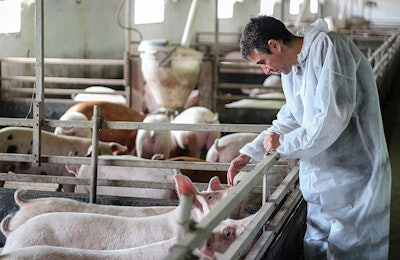
Researchers long suspected that if African swine fever (ASF) reached China, the world would face an outbreak the likes of which it had never seen before.
Despite the headlines, ASF isn’t a particularly contagious disease. Yes, it’s capable of surviving outside a host much longer than most viruses — giving it an ability to remain virulent even after traveling long distances. But on the whole, it doesn’t spread nearly as quickly as other animal diseases such as avian influenza, and small outbreaks have occurred in Africa and across Europe throughout history.
Researchers suspect that human-caused risk factors such as high pig density and poor biosecurity practices ultimately laid the groundwork for today’s large-scale outbreak of ASF.
“We had actually predicted in 2017 that China’s high pig density represented a high risk for a major ASF outbreak to occur,” said Dirk Pfeiffer who, alongside his colleagues, outlined the risk for an outbreak of ASF in China and Vietnam in the journal Veterinary Record. “It was just a matter of time.”
Unlike influenza, ASF is not airborne and doesn’t spread particularly easily — infected pigs don’t become contagious for a week, sometimes longer, after they’ve begun to show symptoms. But ASF persists in the environment for months, and even a small amount of virus can result in illness. Consequently, the virus can be difficult to manage if the disease is not detected, and the infected pigs culled, soon after an outbreak is first detected.
In Africa, where the virus is endemic, outbreaks of ASF typically occur in small pockets that are relatively easy to contain, because that continent’s pig farms tend to be smaller and more widely dispersed. Across Europe, an emphasis on biosecurity measures to control ASF eventually stopped the disease, though it took decades to eradicate ASF entirely.
Perfect storm of risk factors
But China is a perfect storm of risk factors, according to Pfeiffer, director of the Center for Applied One Health Research and Policy Advice at the City University of Hong Kong. The country contains nearly half of the globe’s swine population, producing the high densities that enable the virus to spread. But the majority of these pigs are raised on small farms of less than 100 pigs each, he said, where biosecurity may be less stringent.
To complicate matters, China’s pork industry was on the cusp of industrialization, and farmers had begun shipping swine long distances to slaughterhouses thousands of miles away. All it took to kick off a major outbreak, Pfeiffer said, was the introduction of some contaminated pork product, feed or even equipment to enter China from Russia, where the genotype responsible for this current outbreak was already present.
Given these circumstances, Pfeiffer believes it will take more than a vaccine to bring ASF under control.
“We would not be able to achieve sufficiently high vaccination coverage to result in eradication of the ASF virus,” he said. “We will still need enhanced biosecurity measures and behaviors to be adopted by pig farmers, and it is unlikely that small farms in low- to middle-income countries will do that, for economic and socio-cultural reasons.”
Eradicating the virus in China will require action not only from farmers, but from “millions of stakeholders involved in the pork value chain.” Chinese pig farms will likely become larger and begin to look much more like operations in the U.S. and Europe. But feed manufacturers, truckers and slaughterhouses will also have to reconsider their biosecurity protocol, he said.
“The biosecurity issue is not just about farms,” Pfeiffer said. “It is also about slaughterhouses and pig transport vehicles, which need to be cleaned much better, and if food waste is used as pig feed, it needs to be properly heat treated. So, if you take that altogether, it is quite a tough task to make all those biosecurity changes in the pork food system.”
View our continuing coverage of the African swine fever outbreak.

















